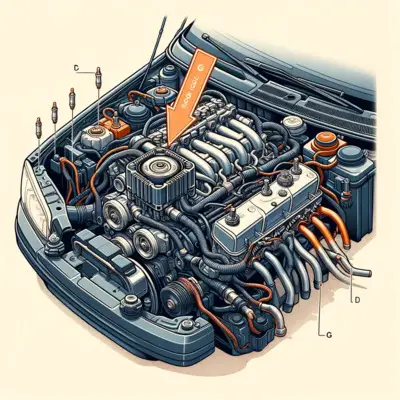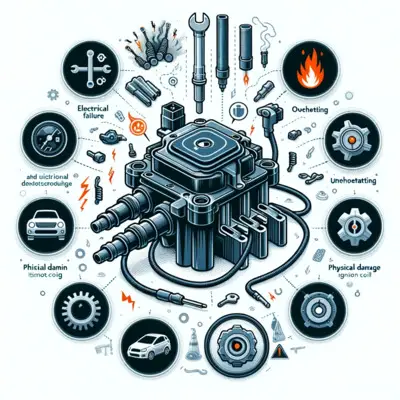The ignition coil is an essential component of a vehicle’s ignition system. It is responsible for converting the low-voltage power from the battery to high-voltage power, which is necessary to create the spark that ignites the fuel in the engine.
Four to eight ICs with letters are standard in most vehicles. This depends on the number of cylinders in the engine. The ICs are labeled with the letters A-B-C-D-E-F-G-H despite the fact that they all have the same purpose.
Where is Ignition Coil G located?
Basically, it’s right over the respective spark plug in cylinder 7.
Read also: Navigating the Mystery of Ignition Coil D and Error P0354
What Does Ignition Coil G Mean?
Ignition coils, also known as “spark coils”, are essential components of gasoline-fueled cars’ ignition systems. Basically, it serves as a step-up transformer, increasing the voltage from the car battery to several thousand volts, which is required to generate sparks at spark plugs. As a result of this spark, combustion begins in the cylinder, bringing the engine to life.
Usually, the number of ignition coils in a car corresponds to the number of cylinders. The ignition coils in a 4-cylinder engine are typically 4 coils, those in a 6-cylinder engine are 6, and those in an 8-cylinder engine are 8, each coil associated with a cylinder.
Manufacturers assign each cylinder in the combustion system a firing order (FO). An engine with four cylinders has an FO of 1-2-3-4, an engine with six cylinders has an FO of 1-2-3-4-5-6, and an engine with eight cylinders has an FO of 1-2-3-4-5-6-7-8.
Each ignition coil is labeled alphabetically according to the numerical order of the cylinders it is connected to. For a four-cylinder engine, the ignition coils are labeled A-B-C-D, with A, B, C, and D representing cylinders #1, #2, #3, and #4.
For a 6-cylinder engine, there are six ignition coils labeled “A-B-C-D-E-F”. Ignition coils A, B, C, D, E, and F correspond to cylinders #1, #2, #3, #4, #5, and #6, respectively. An 8-cylinder engine has 8 ignition coils that are labeled “A-B-C-D-E-F-G-H”. Ignition coils A through H correspond to cylinders #1 through #8 in the same order.
Thus, ignition coil G is only found in automobiles with eight-cylinder engines. With an understanding of ignition coil numbering and labeling, mechanics and car enthusiasts can identify and troubleshoot problems with the ignition system, ensuring a smooth and efficient engine.
Possible Locations of Ignition Coil G
Ignition coil G can be located in several places in a vehicle, depending on the factors mentioned above. Here are some of the possible locations of ignition coil G in a vehicle:
- Near the Engine Block
- Connected to the Spark Plugs
- Housed Within a Casing
- On a Bracket Near the Engine
Steps to Locate Ignition Coil G

If you have the right tools and knowledge, locating ignition coil G in a vehicle is relatively easy. To locate ignition coil G in your vehicle, follow these steps:
Check your vehicle’s owner’s manual
Consult the vehicle owner’s manual for information about where to find the ignition coil. Information about the ignition system and the ignition coil should be included in the manual. Obtaining the owner’s manual is as simple as searching online or contacting the manufacturer.
Look for Visual Clues Under the Hood
Secondly, look for visual clues under the hood. It is common for modern vehicles to mount the ignition coil near the engine. The casing should be plastic or metal and have wires attached. It is also possible to see spark plug wires connected to the ignition coil. Locate the ignition coil by following the wires.
Use an Online Resource or Repair Manual
A repair manual or online resource can help you find the ignition coil if you are still having trouble finding it. Different types of vehicles are explained step-by-step in many online resources. Also, you can purchase a repair manual for your vehicle model, which will provide detailed information about the ignition coil and other ignition system components.
What Problems Can Ignition Coil G Have?

Unable to stop the battery’s voltage from creating sparks due to a manufacturing defect:
If ignition coil G fails to convert power from the battery into a spark at the spark plugs due to a manufacturing defect, it could malfunction. This may result in the engine having trouble starting, misfiring, or performing poorly. It may be necessary to replace the coil if the issue is the result of a manufacturing defect.
Sending irregular sparks to the spark plugs:
It is possible for ignition coil G to malfunction and produce inconsistent sparks. It can result in engine misfires, poor performance, and decreased power. It is possible for erratic sparks to damage spark plugs and other ignition system components. If this problem is to be identified and corrected, the ignition coil must be inspected, tested, or replaced.
Compatibility issue with the rest of the ignition coils:
Another problem could arise if ignition coil G is incompatible with the other coils in the car. For the coils to function properly, they must be identical. If the parts aren’t compatible, the engine may misfire, run poorly, or have diminished power. Changing the incompatible coil for a standard one can fix the problem.
Fried coil:
Fried coils are caused by excessive heat damaging the ignition coil G. As a result, the coil cannot perform its intended function. Misfires, decreased performance, or an inability to start are all signs of an ignition coil that has burned out. In order to resolve the issue, the coil needs to be replaced.
Electrical conductivity issues due to bad wiring or other issues:
It is also possible that ignition coil G has problems with its electrical conductivity. It can be caused by wiring problems or other electrical problems in the ignition system. If the wiring or other parts fail, electricity cannot pass to the ignition coil, rendering the system inoperable. It can result in problems like engine misfires, diminished performance, or even the engine failing to start if the coil does not get enough power. To resolve this issue, the damaged wiring or electrical components must be located and either repaired or replaced.
How Do I Fix Code PO357?
The PO357 warning suggests that the ignition coil G may need to be changed. The first step in solving any issue is always finding its origin. In the event of a problem with electrical conductivity, it may be necessary to inspect and repair the wiring.
If the wiring isn’t the problem, check to see if the coil is the same as the others and works with the cylinder in question. If the remaining coils and cylinder appear to be functioning well, the problematic coil should be swapped out for a new one.
Conclusion
Each IC in your car is labeled with an alphabetic letter that corresponds to the order in which the cylinders it controls are ignited. In a vehicle with 8 cylinders, for instance, the Ignition Coil G is linked to cylinder 7.
knowing the location of ignition coil G in a vehicle is essential for troubleshooting and performing maintenance tasks effectively.
The location of the ignition coil depends on various factors, including the make and model of the vehicle, the type of engine, and the location of other components.
To locate the ignition coil, you can consult the vehicle owner’s manual, look for visual clues under the hood, or use an online resource or repair manual. With the right tools and knowledge, locating ignition coil G in your vehicle should be relatively easy.
